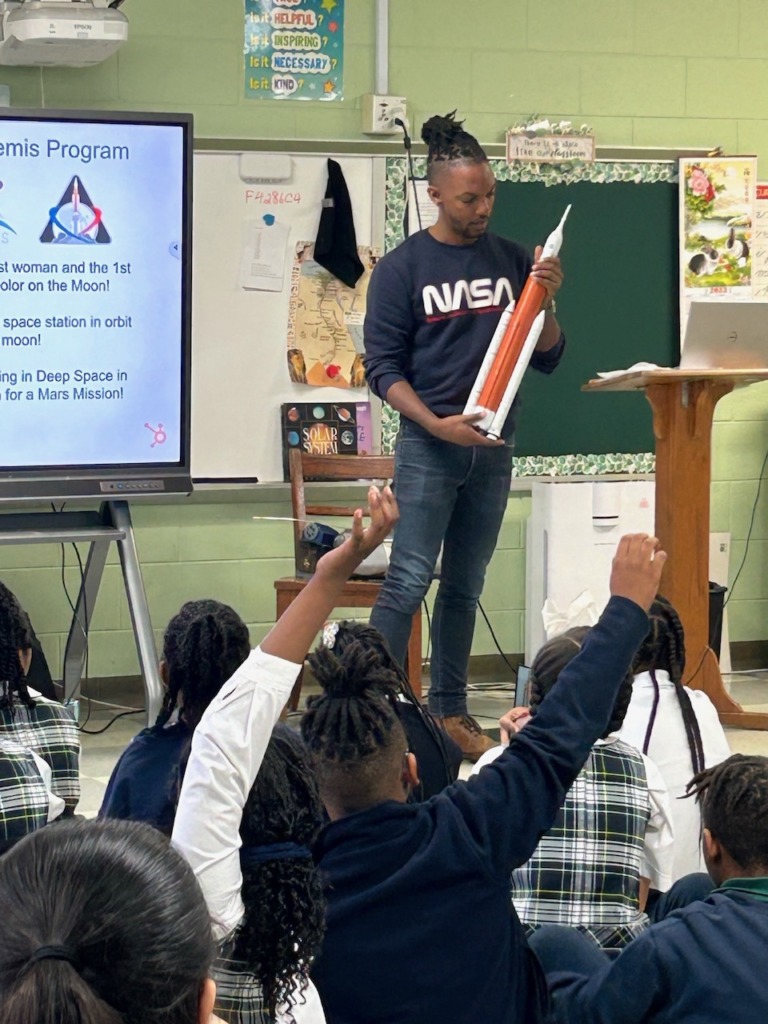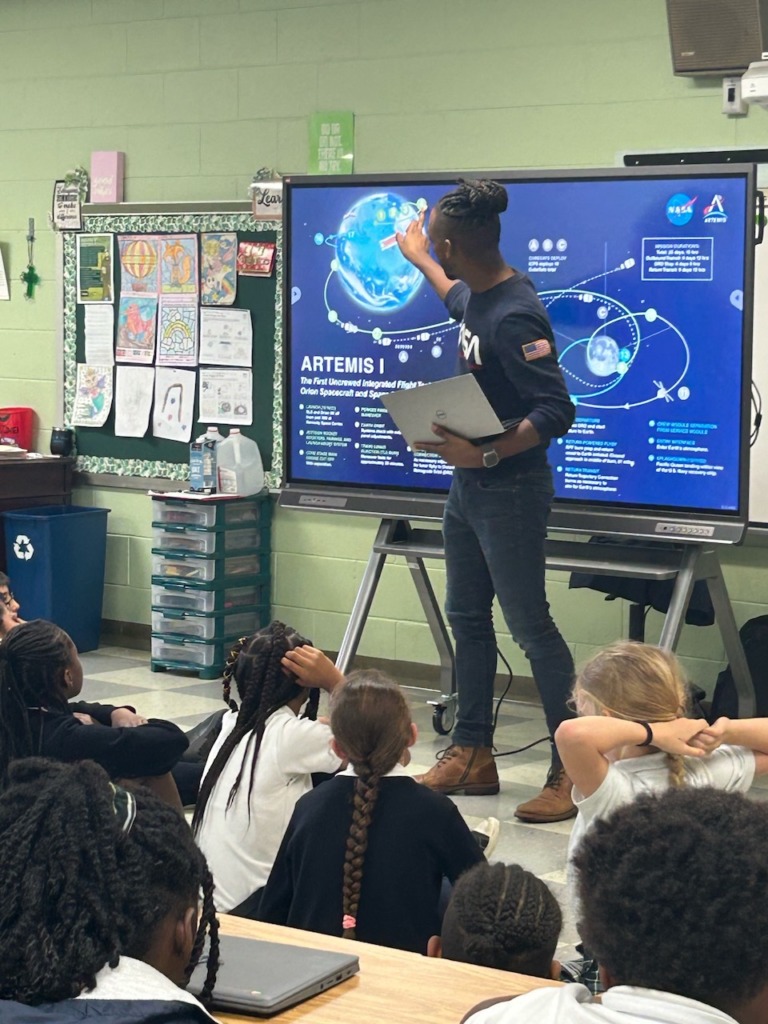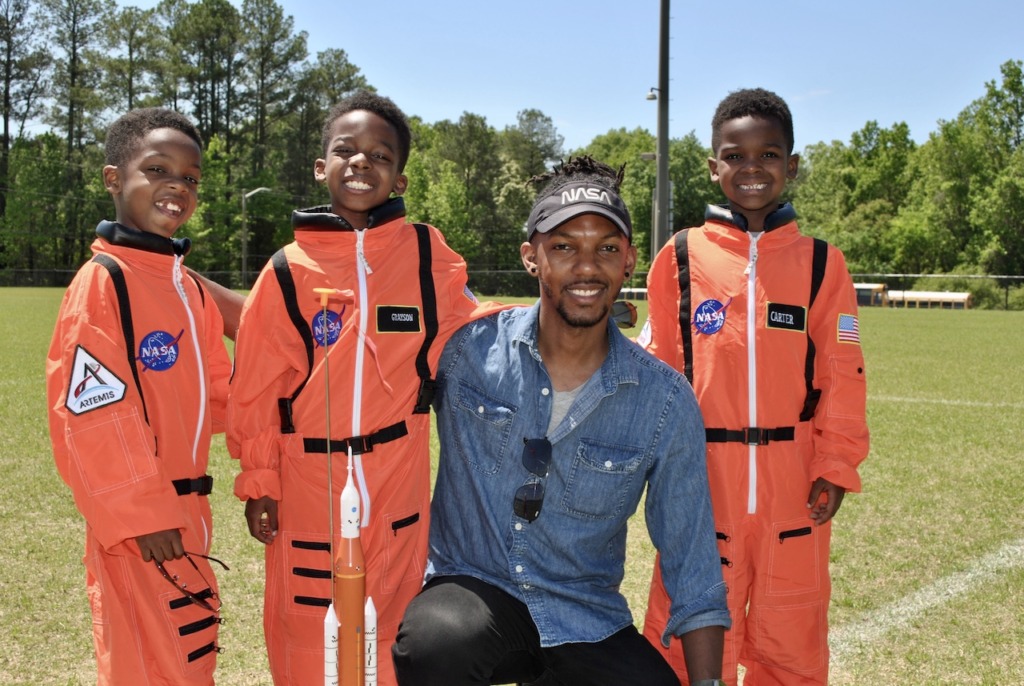NASA is pumping up its Artemis II mission to make history for a number of reasons: it will be the first manned space shuttle to land on the moon in half a century; its crew will include the first person of color and the first woman to land on the moon; and it will carry equipment that has been built and tested by a saint – an All Saints Catholic School, Richmond, “saint,” that is.
All Saints alumnus John Williams attended the Richmond parochial school from junior kindergarten through eighth grade, graduating in 2006. He works as a NASA engineer and hopes to inspire the next generation to set their sights on space, too.
Williams returned to his former school on April 28 to share his experience with students who walk the same halls he once did. He began the day as the guest speaker at the school’s annual “Breakfast with the Saints” fundraiser.
He talked with school supporters, staff and faculty, including some of his former teachers, before speaking to All Saints’ 200 students as part of NASA’s ambassadorship program.

“NASA has always placed a heavy impetus on inspiring the next generation,” said Williams. “They are the ones that will carry the torch, pushing this nation and the world to new frontiers.”
Carrying his own torch in the form of a scale model of a space shuttle, Williams was able to connect with students of every grade level, explaining things in an engaging and informative way.
Students also came prepared, asking a lot of questions which he tried to answer. Little hands shot up like rockets as he fielded inquiries about his personal and professional life, space exploration history, future endeavors, and what would happen if the moon exploded (it would not be good).
Williams shared that from the time he was a baby, he was entranced by his toy cars, trains and planes. Anything that moved grabbed his attention – and it hasn’t let go for 31 years.
His father took him to an air show one day as a child and he fell in love with aviation. In middle school, he learned that engineers build airplanes, so he made that his goal, eventually earning his master’s degree in aerospace engineering from the University of Cincinnati. He spent five years building and testing jet engines for General Electric before being recruited to join NASA four years ago.
Laying the groundwork
One of the major aims of the Artemis program is to lay the groundwork for future missions to Mars, explained Williams.
While it would take six months for astronauts to reach the distant red planet, the moon is much closer and can serve as a testing ground for scientists to learn how best to keep astronauts safe. Williams explained that space travel contains many potential threats to the human body.
Low or zero gravity causes bone mass and muscles to deteriorate and the body overall to become weaker. Sometimes after a mission, astronauts can barely walk as they readjust to earth’s gravity.
Space also exposes astronauts to cosmic radiation, which can mean an increased risk of ailments, including degenerative disease and cancer. Since Mars missions will last two years at a time and mean prolonged exposure to radiation and zero gravity, Artemis’ work on the moon is pivotal to ensuring astronauts’ safety.
Williams has been working on Artemis’ Orion Stage Adapter, overseeing flight readiness for satellites carried within it called BioSentinel CubeSats. Each CubeSat is roughly the size of a shoe box.
BioSentinel will perform long-duration biology experiments in deep space, including experiments with yeast cells, which are similar to human cells. The yeast will be exposed to radiation and monitored by scientists.
Artemis II is slated to launch in November 2024 and several other missions are planned over the coming years. Future Artemis endeavors include Gateway, which will be the first space station to orbit the moon
Gateway will include a scientific laboratory to study deep space as well as dock- ing ports for visiting spacecraft, such as lunar landers and re-supply crafts.

Grounded by faith
While much of his work might be focused on deep space, Williams stays grounded by his deep faith.
“I am a devout Christian,” he pro-claimed. “As such, all understanding comes through faith in Christ.”
“When I look out into the vastness of space, I don’t see a contradiction of Scripture,” he added. “I marvel at God’s design and cherish my ability to comprehend only a small part.”
Williams said people of various faiths are working at NASA, with the same goal of “pushing humanity further than ever before.”
He said something that strikes him about NASA is how people of all walks of life work together, each fulfilling their part of a much greater whole. More than 400,000 people, and hundreds of companies from all 50 states, as well as several other countries, have contributed to the Artemis program.
“I saw a mosaic of all people working on getting us back to the moon,” he recalled. “Men and women of all races and creeds work together toward a common goal. It felt like an accurate representation of America.”
An All Saints’ start
Carmen Murph, who taught Williams at All Saints, was elated to see her former pupil again.
“As a student in the fifth grade, he told me that one day he was going to be a big success in life,” she said. “I myself was overjoyed to see how far he’s come and to see what he is achieving, learning.”
Principal Scott Meadows also had nothing but praise for Williams’ return.
“I think that Mr. Williams embodies what we hope for our students. He was such a strong role model for all of our students, and we hope to have him return,” said the principal. “It is great to see things come full circle.”
When speaking to his young audience, Williams talked about how he started out just as they did — a student at All Saints.
“I didn’t realize until after I left how unique the nurturing experience was at All Saints,” said Williams. “The teachers truly cared for your well-being and success in a way that I haven’t observed elsewhere. The foundation laid there is something I draw inspiration from now, years later.”
After the event, Williams returned to NASA’s flight center in Alabama, where he will continue to work on getting people to the moon, Mars and beyond.
It’s a long way from the school in which he spent 10 years learning and praying but said it’s a trip he wants as many kids as possible to take. The event at All Saints marked his first as a NASA ambassador, and he hopes it’s the first of many.
“Never stop dreaming. The mundaneness of adulthood tends to dampen our childhood hopes, dreams and aspirations,” he said. “Always hold on to a piece of that as you get older.”
Editor’s note: Read more about NASA’s Artemis program.

